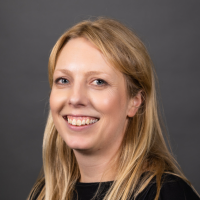
Marine heatwaves and sea ice: implications for Arctic navigational safety
In this blog, Dr Bahareh Kamranzad discusses how her research will support Arctic navigational safety in a rapidly changing climate.
This page is approximately a 4 minute read
This page was published on

Louise Sanger, Head of Research, Interpretation and Engagement
What if we were to do it differently? I expect we have all wondered this at some stage in our lives – perhaps rethinking an accident that could have been avoided, had we just not rushed or had that momentary lapse in concentration (I could have done without needing 15 stitches and a root canal from running to catch a train). Or perhaps it is replaying a conversation in our head over again to play it out differently.
Hindsight can sometimes have negative connotations, but it can also be an incredibly powerful tool if used as a form of learning, a way of thinking, of reflecting on the past to see what parallels there are to today’s challenges.
Our mission as an organisation is to engineer a safer world. Engineering by its nature is iterative. Our archives show that innovations in technology are constantly evolving, constantly seeking to find a new, better, more efficient and safer way to do things.
Learning from failure is a key part of making things safer. Think, for example, of the inquiries that follow a major disaster, such as those that followed the sinking of RMS Titanic and led to the development of the Safety of Life at Sea Convention. Or the work of the Marine Accident Investigation Branch and others in understanding and reporting on incidents and near misses. Lessons from failure – whether these be structural, in design or by human factors are key to understanding how to build or do something differently next time.
Capturing these learnings is key, but there are so many different records, sources of knowledge, evidence and information spread around the world in various repositories. The lessons in these can often get buried, lost and hidden by newer more pressing reports, by changes in personnel and inconsistencies in knowledge management. They may also be overlooked and dismissed simply because they are old or based on something that happened in the past.
This year, Lloyd’s Register Foundation launched its new Global Safety Evidence Centre to systematically identify and compile safety evidence, and make it more accessible and useful. Parallel to this, we have developed a new programme to help feed a ‘learning from the past’ methodology into the Centre’s wider work. Our new Heritage Key Themes look at ways we can utilise our archive, and work with others to develop collaborative research programmes and new projects. We seek to bring cultural heritage information together with other types of data. By working with a wide range of partners and exploring different ways of sharing and interpreting historical records, we can make this information accessible to new, international audiences.
We have some great partnerships to build on. Our Global Maritime Histories project with the International Congress of Maritime Museums brings new and authoritative perspectives into the urgent debate about how to address global safety and sustainability challenges in the maritime economy.
Meanwhile, we are working with The Centre for Port Cities and Maritime Cultures at the University of Portsmouth to deliver ‘Sail to Steam, Carbon to Green’ – a project to empower port communities in the global south to help learn lessons from past maritime energy transitions.
And through Project Tangaroa, we are building a global coalition to clean up potentially polluting wrecks. This project provides another key example of how cultural heritage data (in this case, ship plans, survey reports and other archival sources) are used in tandem with the latest high-resolution subsea surveys to inform wreck interventions. This international collaboration has led to the recent launch of the Malta Manifesto, an urgent call to action to marshal the resources and collective will to protect people and planet from catastrophic oil pollution.
But what next? Reading news updates and headlines in the maritime press frequently inspires me with ideas for research projects (how, for example, can lessons about the dark fleet and aging vessels be informed by history? What else can we understand from supply chain bottlenecks?).
The Heritage Centre’s Key Research Themes structure and amplify our activities in support of the Foundation’s 2024-2029 strategy. These themes are centred around Safety (maritime disasters, shipwrecks and learning from success), Equity and Transparency (contested histories, forgotten voices), and Transitions (ships, ports and technological innovation).
To share your ideas on how we can apply learning from the past, and use our historical records to benefit the maritime sector today, contact hec.info@lrfoundation.org.uk.

